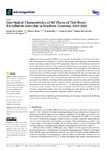2022-03-17Zeitschriftenartikel
Geo-Spatial Characteristics of 567 Places of Tick-Borne Encephalitis Infection in Southern Germany, 2018–2020
Friedsam, Amelie M.
Brady, Oliver J.
Pilic, Antonia
Dobler, Gerhard
Hellenbrand, Wiebke
Nygren, Teresa M.
Tick-borne encephalitis (TBE) is a growing public health problem with increasing incidence and expanding risk areas. Improved prevention requires better understanding of the spatial distribution and ecological determinants of TBE transmission. However, a TBE risk map at sub-district level is still missing for Germany. We investigated the distribution and geo-spatial characteristics of 567 self-reported places of probable TBE infection (POI) from 359 cases notified in 2018–2020 in the study area of Bavaria and Baden-Wuerttemberg, compared to 41 confirmed TBE foci and 1701 random comparator places. We built an ecological niche model to interpolate TBE risk to the entire study area. POI were distributed heterogeneously at sub-district level, as predicted probabilities varied markedly across regions (range 0–93%). POI were spatially associated with abiotic, biotic, and anthropogenic geo-spatial characteristics, including summer precipitation, population density, and annual frost days. The model performed with 69% sensitivity and 63% specificity at an optimised probability threshold (0.28) and an area under the curve of 0.73. We observed high predictive probabilities in small-scale areas, consistent with the known circulation of the TBE virus in spatially restricted microfoci. Supported by further field work, our findings may help identify new TBE foci. Our fine-grained risk map could supplement targeted prevention in risk areas.
Files in this item

